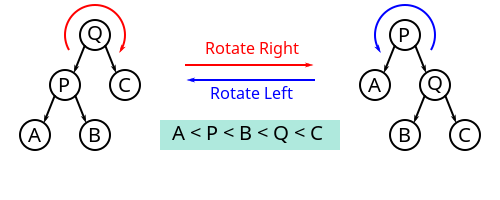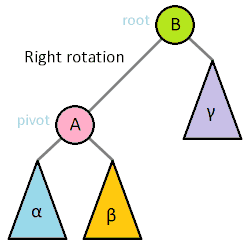红黑树
January 11, 2022
树,保持高效在于平衡,高度低。
红黑树如何做到的呢?
定义 #
wiki #
红黑树(英语:Red–black tree)是一种自平衡二叉查找树,是在计算机科学中用到的一种数据结构,典型用途是实现关联数组。它在1972年由鲁道夫·贝尔发明,被称为"对称二叉B树",它现代的名字源于Leo J. Guibas和罗伯特·塞奇威克于1978年写的一篇论文。红黑树的结构复杂,但它的操作有着良好的最坏情况运行时间,并且在实践中高效:它可以在
O(log n)时间内完成查找、插入和删除,这里的n是树中元素的数目。
性质 #
红黑树是每个节点都带有颜色属性的二叉查找树,颜色为红色或黑色。在二叉查找树强制一般要求以外,对于任何有效的红黑树我们增加了如下的额外要求:
节点是红色或黑色。
根是黑色。
所有叶子都是黑色(叶子是NIL节点)。
每个红色节点必须有两个黑色的子节点。(从每个叶子到根的所有路径上不能有两个连续的红色节点。)
从**任一节点到其每个叶子**的所有简单路径都包含**相同数目的黑色节点**。
一句话概况:或红或黑,首尾皆黑,红子必黑,任一点至所有尾含黑同数。
为确保任一点至所有尾含黑同数,路径中必须插入红点,而在哪个位置插呢(必须考虑红子必黑原则)?
这些约束确保了红黑树的关键特性:从根到叶子的最长的可能路径不多于最短的可能路径的两倍长。结果是这个树大致上是平衡的。因为操作比如插入、删除和查找某个值的最坏情况时间都要求与树的高度成比例,这个在高度上的理论上限允许红黑树在最坏情况下都是高效的,而不同于普通的二叉查找树。
要知道为什么这些性质确保了这个结果,注意到性质4导致了路径不能有两个毗连的红色节点就足够了。最短的可能路径都是黑色节点,最长的可能路径有交替的红色和黑色节点。因为根据性质5所有最长的路径都有相同数目的黑色节点,这就表明了没有路径能多于任何其他路径的两倍长。
在很多树数据结构的表示中,一个节点有可能只有一个子节点,而叶子节点包含数据。用这种范例表示红黑树是可能的,但是这会改变一些性质并使算法复杂。为此,本文中我们使用"nil叶子"或"空(null)叶子",如上图所示,它不包含数据而只充当树在此结束的指示。这些节点在绘图中经常被省略,导致了这些树好像同上述原则相矛盾,而实际上不是这样。与此有关的结论是所有节点都有两个子节点,尽管其中的一个或两个可能是空叶子。
实现 #
操作 #
因为每一个红黑树也是一个特化的二叉查找树,因此红黑树上的只读操作与普通二叉查找树上的只读操作相同。然而,在红黑树上进行插入操作和删除操作会导致不再符合红黑树的性质。恢复红黑树的性质需要少量(O(log n))的颜色变更(实际是非常快速的)和不超过三次树旋转(对于插入操作是两次)。虽然插入和删除很复杂,但操作时间仍可以保持为O(log n)次。
- 我们首先以二叉查找树的方法增加节点并标记它为红色。(如果设为黑色,就会导致根到叶子的路径上有一条路上,多一个额外的黑节点,这个是很难调整的。但是设为红色节点后,可能会导致出现两个连续红色节点的冲突,那么可以通过**颜色调换(color flips)和 树旋转**来调整。)
树旋转 #
对二叉树的一种操作,不影响元素的顺序,但会改变树的结构,将一个节点上移、一个节点下移。树旋转会改变树的形状,因此常被用来将较小的子树下移、较大的子树上移,从而降低树的高度、提升许多树操作的效率。


对一棵树进行旋转时,这棵树的根节点是被旋转的两棵子树的父节点,称为旋转时的根(英语:root);如果节点在旋转后会成为新的父节点,则该节点为旋转时的转轴(英语:pivot)。
上图中,树的右旋操作以 Q 为根、P 为转轴,会将树顺时针旋转。相应的逆操作为左旋,会以 Q 为转轴,将树逆时针旋转。
理解树旋转过程的关键,在于理解其中不变的约束。旋转操作不会导致叶节点顺序的改变(可以理解为旋转操作前后,树的中序遍历结果是一致的),旋转过程中也始终受二叉搜索树的主要性质约束:右子节点比父节点大、左子节点比父节点小。尤其需要注意的是,进行右旋转时,旋转前根的左节点的右节点(例如上图中以 Q 为根的 B 节点)会变成根的左节点,根本身则在旋转后会变成新的根的右节点,而在这一过程中,整棵树一直遵守着前面提到的几个约束。相反的左旋转操作亦然。
如果将根记为 Root、转轴记为 Pivot、子节点中与旋转方向相同的一侧记为 RS(旋转侧,英语:Rotation Side)、旋转对侧记为 OS(英语:Opposite Side),则上图中 Q 节点的 RS 为 C、OS 为 P,将其右旋转的伪代码为:
Pivot = Root.OS
Root.OS = Pivot.RS
Pivot.RS = Root
Root = Pivot
该操作为常数时间复杂度。
代码 #
package redblacktree
import "fmt"
type Color int
const (
Red Color = 0
Black Color = 1
)
func (color Color) output() string {
switch color {
case Red:
return "RED"
case Black:
return "BLACK"
default:
return ""
}
}
type Node struct {
value int
color Color
leftTree, rightTree, parent *Node
}
// Grandparent 爷
func (node *Node) Grandparent() *Node {
if node.parent == nil {
return nil
}
return node.parent.parent
}
// Uncle 叔伯
func (node *Node) Uncle() *Node {
if node.Grandparent() == nil {
return nil
}
if node.parent == node.Grandparent().rightTree {
return node.Grandparent().leftTree
} else {
return node.Grandparent().rightTree
}
}
// Sibling 兄弟
func (node *Node) Sibling() *Node {
if node.parent == nil {
return nil
}
if node.parent.leftTree == node {
return node.parent.rightTree
} else {
return node.parent.leftTree
}
}
type RBT struct {
root, NIL *Node
}
// 右翻转
// 涉及节点:本节点、父节点的左子节点、右节点、根节点、爷节点
// 移动方向:
func (t *RBT) rotateRight(node *Node) {
gp := node.Grandparent()
fa := node.parent
rt := node.rightTree
fa.leftTree = rt
if rt != t.NIL {
rt.parent = fa
}
node.rightTree = fa
fa.parent = node
if t.root == fa {
t.root = rt
}
node.parent = gp
if gp != nil {
if gp.leftTree == fa {
gp.leftTree = node
} else {
gp.rightTree = node
}
}
}
func (t *RBT) rotateLeft(node *Node) {
if node.parent == nil {
t.root = node
return
}
gp := node.Grandparent()
fa := node.parent
lt := node.leftTree
fa.rightTree = lt
if lt != t.NIL {
lt.parent = fa
}
node.leftTree = fa
fa.parent = node
if t.root == fa {
t.root = node
}
node.parent = gp
if gp != nil {
if gp.leftTree == fa {
gp.leftTree = node
} else {
gp.rightTree = node
}
}
}
func (t *RBT) inorder(node *Node, level int) {
level++
var prefix string
for i := 1; i < level; i++ {
prefix += " "
}
if node == t.NIL {
fmt.Printf("%s-NIL(%s)\n", prefix, node.color.output())
return
}
if node.leftTree != nil {
t.inorder(node.leftTree, level)
}
fmt.Printf("%s-%d(%s)\n", prefix, node.value, node.color.output())
if node.rightTree != nil {
t.inorder(node.rightTree, level)
}
}
func (t *RBT) getSmallestChild(node *Node) *Node {
if node.leftTree == t.NIL {
return node
}
return t.getSmallestChild(node.leftTree)
}
func (t *RBT) GetMaxChild(node *Node) *Node {
if node.rightTree == nil {
return node
}
return t.GetMaxChild(node.rightTree)
}
func (t *RBT) deleteChild(node *Node, data int) bool {
if node.value > data {
if node.leftTree == t.NIL {
return false
}
return t.deleteChild(node.leftTree, data)
} else if node.value < data {
if node.rightTree == t.NIL {
return false
}
return t.deleteChild(node.rightTree, data)
} else if node.value == data {
if node.rightTree == t.NIL {
t.deleteOneChild(node)
return true
}
smallest := t.getSmallestChild(node.rightTree)
// swap(p->value, smallest->value)
node.value, smallest.value = smallest.value, node.value
t.deleteOneChild(smallest)
return true
}
return false
}
func (t *RBT) deleteOneChild(node *Node) {
var child *Node
if node.leftTree == t.NIL {
child = node.rightTree
} else {
child = node.leftTree
}
if node.parent == nil && node.leftTree == t.NIL && node.rightTree == t.NIL {
node = nil
t.root = node
return
}
if node.parent == nil {
child.parent = nil
t.root = child
t.root.color = Black
return
}
if node.parent.leftTree == node {
node.parent.leftTree = child
} else {
node.parent.rightTree = child
}
child.parent = node.parent
if node.color == Black {
if child.color == Red {
child.color = Black
} else {
t.deleteCase(child)
}
}
}
func (t *RBT) deleteCase(node *Node) {
if node.parent == nil {
node.color = Black
return
}
if node.Sibling().color == Red {
node.parent.color = Red
node.Sibling().color = Black
if node == node.parent.leftTree {
t.rotateLeft(node.parent)
} else {
t.rotateRight(node.parent)
}
}
if node.parent.color == Black && node.Sibling().color == Black &&
node.Sibling().leftTree.color == Black &&
node.Sibling().rightTree.color == Black {
node.Sibling().color = Red
t.deleteCase(node.parent)
} else if node.parent.color == Red &&
node.Sibling().color == Black &&
node.Sibling().leftTree.color == Black &&
node.Sibling().rightTree.color == Black {
node.Sibling().color = Red
node.parent.color = Black
} else {
if node.Sibling().color == Black {
if node == node.parent.leftTree &&
node.Sibling().leftTree.color == Red &&
node.Sibling().rightTree.color == Black {
node.Sibling().color = Red
node.Sibling().leftTree.color = Black
t.rotateRight(node.Sibling().leftTree)
} else if node == node.parent.rightTree &&
node.Sibling().leftTree.color == Black &&
node.Sibling().rightTree.color == Red {
node.Sibling().color = Red
node.Sibling().rightTree.color = Black
t.rotateLeft(node.Sibling().rightTree)
}
}
node.Sibling().color = node.parent.color
node.parent.color = Black
if node == node.parent.leftTree {
node.Sibling().rightTree.color = Black
t.rotateLeft(node.Sibling())
} else {
node.Sibling().leftTree.color = Black
t.rotateRight(node.Sibling())
}
}
}
func (t *RBT) insert(node *Node, data int) {
if node.value >= data {
if node.leftTree != nil && node.leftTree != t.NIL {
t.insert(node.leftTree, data)
} else {
tmp := new(Node)
tmp.value = data
tmp.leftTree = t.NIL
tmp.rightTree = t.NIL
tmp.parent = node
node.leftTree = tmp
t.insertCase(tmp)
}
} else {
if node.rightTree != nil && node.rightTree != t.NIL {
t.insert(node.rightTree, data)
} else {
tmp := new(Node)
tmp.value = data
tmp.leftTree = t.NIL
tmp.rightTree = t.NIL
tmp.parent = node
node.rightTree = tmp
t.insertCase(tmp)
}
}
}
func (t *RBT) insertCase(node *Node) {
if node.parent == nil {
t.root = node
node.color = Black
return
}
fmt.Printf("insertCase: node: %+v, parent: %+v\n", node, node.parent)
// t.inorder(t.root)
if node.parent.color == Red {
if node.Uncle() != nil && node.Uncle().color == Red {
node.parent.color = Black
node.Uncle().color = Black
node.Grandparent().color = Red
t.insertCase(node.Grandparent())
} else {
if node.parent.rightTree == node &&
node.Grandparent().leftTree == node.parent {
t.rotateLeft(node)
node.color = Black
node.parent.color = Red
t.rotateRight(node)
} else if node.parent.leftTree == node &&
node.Grandparent().rightTree == node.parent {
t.rotateRight(node)
node.color = Black
node.parent.color = Red
t.rotateLeft(node)
} else if node.parent.leftTree == node &&
node.Grandparent().leftTree == node.parent {
node.parent.color = Black
node.Grandparent().color = Red
t.rotateRight(node.parent)
} else if node.parent.rightTree == node &&
node.Grandparent().rightTree == node.parent {
node.parent.color = Black
node.Grandparent().color = Red
t.rotateLeft(node.parent)
}
}
}
}
func (t *RBT) DeleteTree(node *Node) {
if node == nil || node == t.NIL {
return
}
t.DeleteTree(node.leftTree)
t.DeleteTree(node.rightTree)
}
func (t *RBT) search(node *Node, data int) *Node {
if node == nil {
return nil
}
if node.value > data {
if node.leftTree == nil {
return nil
}
return t.search(node.leftTree, data)
} else if node.value < data {
if node.rightTree == nil {
return nil
}
return t.search(node.rightTree, data)
} else {
return node
}
}
func (t *RBT) Inorder() {
if t.root == nil {
return
}
t.inorder(t.root, 0)
fmt.Println("")
}
func (t *RBT) Search(data int) (*Node, bool) {
if t.root == nil {
return nil, false
}
node := t.search(t.root, data)
return node, node != nil
}
func (t *RBT) Insert(data int) {
if t.root == nil {
t.root = new(Node)
t.root.color = Black
t.root.leftTree = t.NIL
t.root.rightTree = t.NIL
t.root.value = data
} else {
t.insert(t.root, data)
}
}
func (t *RBT) Delete(data int) bool {
return t.deleteChild(t.root, data)
}
func NewRBT() *RBT {
return &RBT{
root: nil,
NIL: &Node{color: Black},
}
}
分析 #
树皆有根,根连干,干连枝,枝连叶,盘根错节。通过红黑树的形式来管理这颗树,让树的营养均衡,从而保持长久的生命力。
命运扭成一个死结,怎么办?不如分散为独立事件,各自处理。分合之间,分久必合,合久必分。集权者只顾为己争权夺利,越集中越凶险,故分;诸侯王枉顾生死不辩是非互相倾轧,越分散越苦痛,故合。是合,是分,由谁定呢?什么时候定呢?感觉(分久必合,合久必分)这句话更多是作者的一种感慨,中间有太多无奈和哀伤。
达成共识,才能动工。社会是这样,皆因大部分人都认可这样。要想改变,从观念开始。只有达成新的共识,才能改变。至少要让有能力动手的达成共识。
如果都在一棵树上,树倒猢狲散,那么大家都会极力促成共识的达成吧。不过现实往往不只一颗树,并且每棵树还各自不一样,所以要想达成共识非常困难。如果各自有意愿往共识达成努力,也还能多交流、沟通,以图共识。万一各怀异心,就无法一致了。此时,付出更多的一方反而受伤越多、损失越重。